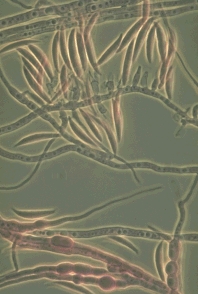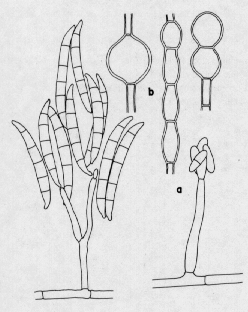Main page <> Index of descriptions <> Previous description <> Fusarium <> Next description
Fusarium


Most characteristic are the colourless spores (conidia), which are canoe-shaped in side view, have a distinct "foot cell" at the lower end, and are divided by several cross-walls. The conidiophores are often clustered to form sporodochia and produce large pasty masses of spores from tapered phialides. Two other spore forms may occur, microconidia (a) resembling spores and phialides of Acremonium, and chlamydospores (b), thick-walled swellings along the filaments. Cultures may be brightly coloured. Common in soil and dead or living plants; often causing plant disease.
Classification: Nectriaceae. Holomorphs: Albonectria, Coralomycetella, Gibberella, Haematonectria, and possibly others. Ref: Booth 1971b, 1977; Burgess, et al., 1988; Gerlach and Nirenberg, 1982; Nelson, et al., 1983.